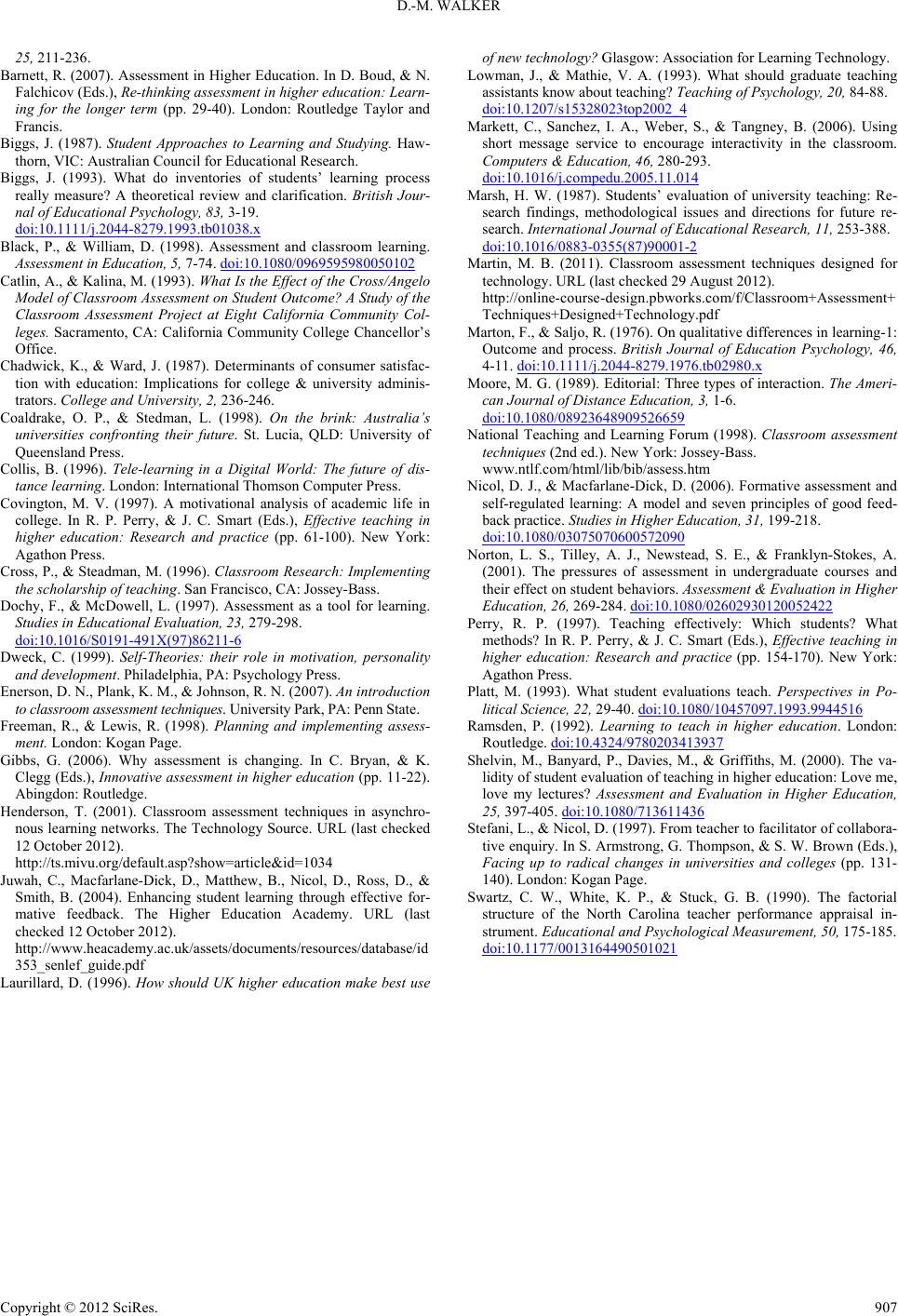
D.-M. WALKER
25, 211-236.
Barnett, R. (2007). Assessment in Higher Education. In D. Boud, & N.
Falchicov (Eds.), Re-thinki ng ass ess me nt in higher education: Learn-
ing for the longer term (pp. 29-40). London: Routledge Taylor and
Francis.
Biggs, J. (1987). Student Approaches to Learning and Studying. Haw-
thorn, VIC: Australian Council for Edu cation al Re search.
Biggs, J. (1993). What do inventories of students’ learning process
really measure? A theoretical review and clarification. British Jour-
nal of Educational Psychology, 83, 3-19.
doi:10.1111/j.2044-8279.1993.tb01038.x
Black, P., & William, D. (1998). Assessment and classroom learning.
Assessment in Education, 5, 7- 74. doi:10.1080/0969595980050102
Catlin, A., & Kalina, M. (1993). What Is the Effect of the Cross/Angelo
Model of Classroom Assessment on Student Outcome? A Study of the
Classroom Assessment Project at Eight California Community Col-
leges. Sacramento, CA: California Community College Chancellor’s
Office.
Chadwick, K., & Ward, J. (1987). Determinants of consumer satisfac-
tion with education: Implications for college & university adminis-
trators. College and University, 2, 236-246.
Coaldrake, O. P., & Stedman, L. (1998). On the brink: Australia’s
universities confronting their future. St. Lucia, QLD: University of
Queensland Press.
Collis, B. (1996). Tele-learning in a Digital World: The future of dis-
tance learning. London: International Thomson Computer Press.
Covington, M. V. (1997). A motivational analysis of academic life in
college. In R. P. Perry, & J. C. Smart (Eds.), Effective teaching in
higher education: Research and practice (pp. 61-100). New York:
Agathon Press.
Cross, P., & Steadman, M. (1996). Classroom Research: Implementing
the scholarship of teaching. San Francisco, CA: Jossey-Bass.
Dochy, F., & McDowell, L. (1997). Assessment as a tool for learning.
Studies in Educational Evaluation, 23, 279-298.
doi:10.1016/S0191-491X(97)86211-6
Dweck, C. (1999). Self-Theories: their role in motivation, personality
and development. Philadelphia, PA: Psychology Press.
Enerson, D. N., Plank, K. M., & Johnson, R. N. (2007). An introduction
to classroom assessment techniques. University Park, PA: Penn State.
Freeman, R., & Lewis, R. (1998). Planning and implementing assess-
ment. London: Kogan Page.
Gibbs, G. (2006). Why assessment is changing. In C. Bryan, & K.
Clegg (Eds.), Innovative assessment in higher education (pp. 11-22).
Abingdon: Routledge.
Henderson, T. (2001). Classroom assessment techniques in asynchro-
nous learning networks. The Technology Source. URL (last checked
12 October 2012).
http://ts.mivu.org/default.asp?show=article&id=1034
Juwah, C., Macfarlane-Dick, D., Matthew, B., Nicol, D., Ross, D., &
Smith, B. (2004). Enhancing student learning through effective for-
mative feedback. The Higher Education Academy. URL (last
checked 12 October 2012).
http://www.heacademy.ac.uk/assets/documents/resources/database/id
353_senlef_guide.pdf
Laurillard, D. (1996). How should UK higher education make best use
of new technology? Glasgow: Association for L earning Technology.
Lowman, J., & Mathie, V. A. (1993). What should graduate teaching
assistants know about t eaching? Teaching of Psycholo gy, 20, 84-88.
doi:10.1207/s15328023top2002_4
Markett, C., Sanchez, I. A., Weber, S., & Tangney, B. (2006). Using
short message service to encourage interactivity in the classroom.
Computers & Education, 46, 280-293.
doi:10.1016/j.compedu.2005.11.014
Marsh, H. W. (1987). Students’ evaluation of university teaching: Re-
search findings, methodological issues and directions for future re-
search. International Journal of Educational Research, 11, 253-388.
doi:10.1016/0883-0355(87)90001-2
Martin, M. B. (2011). Classroom assessment techniques designed for
technology. URL (last checked 29 August 2012).
http://online-course-design.pbworks.com/f/Classroom+Assessment+
Techniques+Designed+Technology.pdf
Marton, F., & Saljo, R. (1976). On qualitative differences in learning-1:
Outcome and process. British Journal of Education Psychology, 46,
4-11. doi:10.1111/j.2044-8279.1976.tb02980.x
Moore, M. G. (1989). Editorial: Three types of interaction. The Ameri-
can Journal of Distance Education, 3, 1-6.
doi:10.1080/08923648909526659
National Teaching and Learning Forum (1998). Classroom assessment
techniques (2nd ed.). New York: Jossey-Bass.
www.ntlf.com/html/lib/bib/assess.htm
Nicol, D. J., & Macfarlane-Dick, D. (2006). Formative assessment and
self-regulated learning: A model and seven principles of good feed-
back practice. Studies in Higher Education, 31, 199-218.
doi:10.1080/03075070600572090
Norton, L. S., Tilley, A. J., Newstead, S. E., & Franklyn-Stokes, A.
(2001). The pressures of assessment in undergraduate courses and
their effect on student behaviors. Assessment & Evaluation in Higher
Education, 26, 269-284. doi:10.1080/02602930120052422
Perry, R. P. (1997). Teaching effectively: Which students? What
methods? In R. P. Perry, & J. C. Smart (Eds.), Effective teaching in
higher education: Research and practice (pp. 154-170). New York:
Agathon Press.
Platt, M. (1993). What student evaluations teach. Perspectives in Po-
litical Science, 22, 29-40. doi:10.1080/10457097.1993.9944516
Ramsden, P. (1992). Learning to teach in higher education. London:
Routledge. doi:10.4324/9780203413937
Shelvin, M., Banyard, P., Davies, M., & Griffiths, M. (2000). The va-
lidity of student evaluation of teaching in higher education: Love me,
love my lectures? Assessment and Evaluation in Higher Education,
25, 397-405. doi:10.1080/713611436
Stefani, L., & Nicol, D. (1997). From teacher to facilitator of collabora-
tive enquiry. In S. Armstrong, G. Thompson, & S. W. Brown (Eds.),
Facing up to radical changes in universities and colleges (pp. 131-
140). London: Kogan Page.
Swartz, C. W., White, K. P., & Stuck, G. B. (1990). The factorial
structure of the North Carolina teacher performance appraisal in-
strument. Educational and Psychological Measurement, 50, 175-185.
doi:10.1177/0013164490501021
Copyright © 2012 SciRes. 907